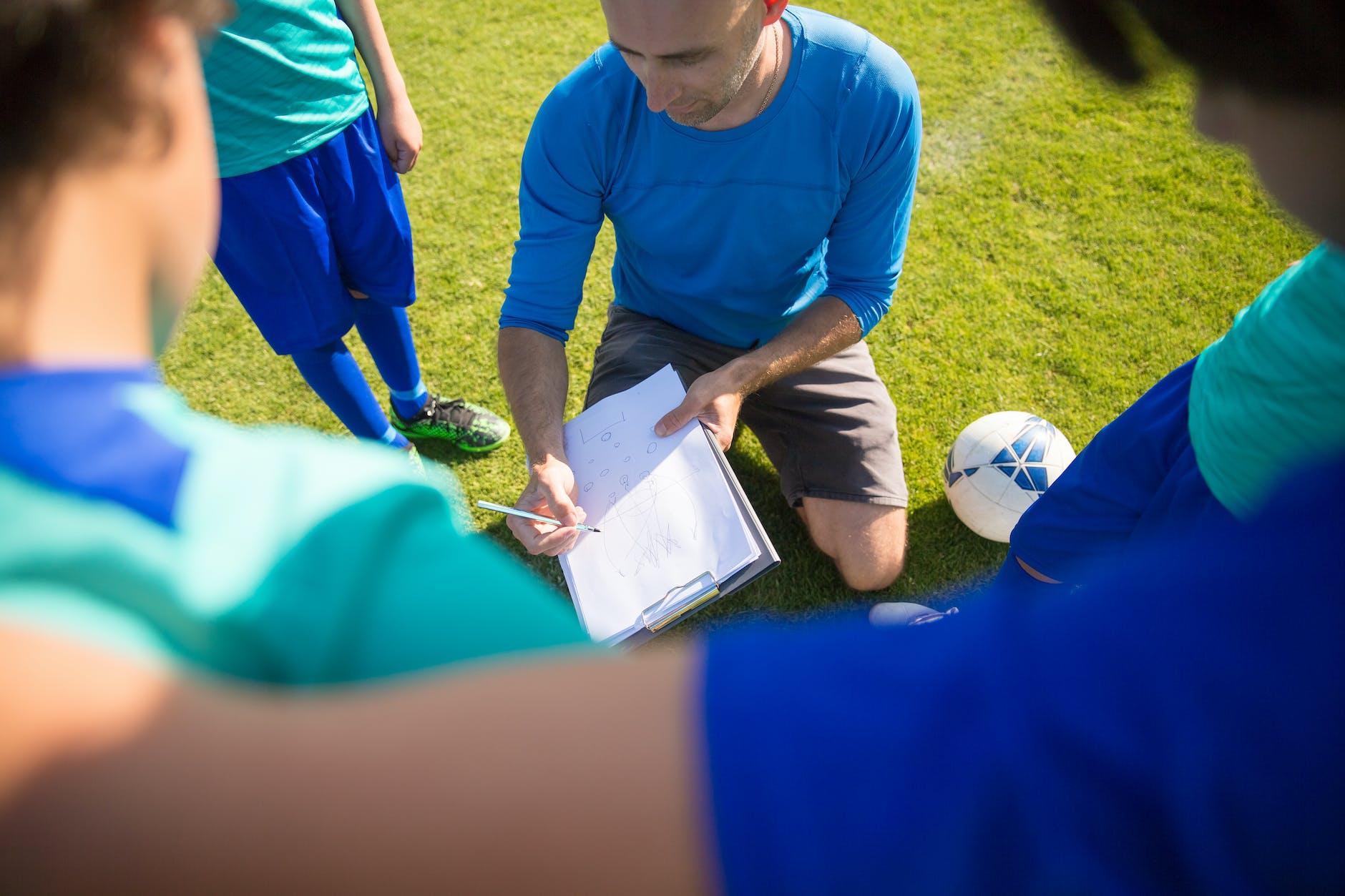Football is a sport that captivates millions of fans worldwide. While goals and attacking play often steal the spotlight, defending is an equally important aspect of the game. A solid defensive strategy can be the difference between victory and defeat. In this comprehensive guide, we will delve deep into the art of defending in football. From the fundamentals to advanced tactics, we will explore the skills, techniques, and mindset required to excel as a defender. So, let’s kick off and discover the secrets of defending in football!

Elevate Your Coaching Journey
Are you ready to take your coaching career to the next level? Look no further than FootballCoach365, your ultimate destination for top-notch coaching and mentoring services.
Join the FootballCoach365 community today and experience the transformative power of coaching and mentoring.
Table of Contents
Defending in Football: A Strong Backline is the Key
A tough defensive line is necessary in football, serving as the foundation of a strong and efficient defensive strategy. Defenders assume a pivotal role in safeguarding their team’s goal, discomforting the attacking team, and denying scoring opportunities. To excel in this position, defenders must possess a combination of physical attributes, technical skills, and tactical awareness.
The physical attributes of defenders hold paramount importance since they frequently engage in duels with opposing players.
Defenders require more than just physical attributes; they must also possess exceptional technical skills and highly tactical awareness. Ball control and passing accuracy play a significant role as defenders often initiate attacking moves from the backline. Proper positioning is equally important as it enables defenders to anticipate their opponents’ movements and intercept passes.
A great example of technical prowess in individual defending can be observed when a full-back with exceptional ball control embarks on a skillful dribble down the flank. With their superior control, they can maneuver past opponents with finesse, showcasing their ability to maintain possession while under pressure. This skilled full-back can then deliver an accurate cross into the box, setting up a scoring opportunity for a teammate.
The need for tactical judgment emerges as an indispensable element of their role. Defenders must have a profound comprehension of the game, proficiently decode any on-field scenario, and exhibit smart decision-making processes to overcome any potential danger. They must analyze the positioning of opposing players, foresee their movements on the ball and off the ball, and engage in communication with their teammates to collectively deal with these situations
A cohesive backline relies heavily on effective teamwork and communication among defenders. They must have a strong understanding of each other’s strengths, weaknesses, and preferred positions to form a solid defensive unit. Defenders need to coordinate their movements, provide cover when a teammate is out of position, and maintain a compact defensive shape to deny the opposition space to exploit. For example, a center-back and full-back may communicate seamlessly, with the full-back tucking inside to cover the central areas when the center-back steps out to press an opponent between the lines, creating a defensive triangle with the second center-back and limiting the attacking options for the opponent.
ELITE ACADEMY COACHING – THE SECRETS BEHIND THE DEVELOPMENT PROGRAM FOR PEP GUARDIOLA’S METHODOLOGY

The Secrets Behind the Development Program for Pep Guardiola’s Methodology
- Build-up Phase 1: Short Build-up Play from the GK
- Build-up Phase 2: Midfield Combination Play
- Build-up Phase 3: Finishing the Attack (Final Third)
- Pressing from the Front
- Defending in Midfield
- Defending Around the BoxPlay Your Position (the ball comes to you, don’t go to the ball)
- Short Build-up Play from the GK with Full Backs Pushed Up
- Possession with a Purpose – Create Overloads + Break Lines
- Midfielders Initiate Combination Play (Rotations)
- Control to Create Opportunities to Score
- Play Through the Centre (Penetration) and Wide (Crossing)
- Aggressive High Press to Win Possession Quickly or Force Mistakes
- Create Numerical Superiority in All Transition Moments in the Game
The Role of a Defender
Defenders play a vital role in the defensive formation of a team and in collective defending in football. They have the important duty of nullifying the attacking dangers posed by the opposing team and skilled forwards and wingers. The main goal of a defender is to safeguard the goal and deny the opposing team to score. Presented below are several significant responsibilities of a defender:
- Marking: Effective marking is a defensive skill in which soccer players closely monitor and follow their opponents on the field, aiming to restrict their movement, reduce their impact in the attacking area, and if possible recover the ball. This approach involves maintaining close proximity to the assigned opponent and applying pressure when appropriate. By doing so, defenders can interrupt the flow of the opposing team’s play, making it challenging for them to generate scoring opportunities. An example is a center-back who is stepping up to reduce the space between him and an offensive player between the lines who is positioned behind the team’s midfield line.
- Tackling: Well-timed tackles are essential for winning the ball back and breaking up the opponent’s attacks. Defenders must master the art of tackling, knowing when to commit and when to hold back. Proper technique and timing are crucial to avoid committing fouls that could lead to penalties or dangerous free-kicks. By executing clean tackles, defenders can regain possession for their team and halt the opposition’s progress.
- Heading: Defenders frequently encounter situations where they must excel in aerial duels and clear the ball from perilous zones. Whether they are defending against corner kicks, crosses, or long balls, a defender’s ability to dominate in the air can effectively thwart scoring opportunities for the opposing team. One illustrative scenario is during a corner kick, where a defender may outleap an opposing forward and use their head to redirect the ball away from the goal, thus preventing a potential chance to score.
- Interceptions: Anticipating passes and intercepting them is an invaluable skill that can disrupt the flow of the opponent’s play. By reading the game well and positioning themselves intelligently, defenders can cut off passing lanes and regain possession for their team. For instance, a defender may anticipate a through ball and intercept it before it reaches the intended target, breaking down the opposition’s offense and initiating a counter-attack for their team. This approach is called “ defending in front of the attacker“.

Marking: Center back jumping forward to mark the attacking midfielder positioned between the lines

Interception: Center back instead of following the movement of the forward, moves to the ball’s trajectory to intercept it
Essential Skills for Defenders
To master defending in football, players must cultivate and perfect particular aptitudes. Presented below are key proficiencies essential for defenders:
- Positioning: Proper positioning is undeniably vital for defenders to effectively foresee and react to the opponent’s movements. By assuming a suitable reaction to the opponent’s movements, defenders can effectively intercept passes, and shots, and swiftly engage offensive players.
- Timing: Timing is everything in defending in football. A well-timed tackle can prevent an attacker’s progress and regain possession for the defending team. Conversely, misjudged tackles can lead to fouls or penalty kicks. Developing a sense of timing is crucial for defenders. It involves understanding when to challenge the ball and when to delay or contain the attacking player.
- Strength: Defenders should be strong enough to triumph in aerial duels, and overpower opponents in one-on-one situations which includes contact, such as defending an opponent who plays with his back.
- Speed and Agility: Defenders need to display enough speed and agility to keep up with the fast pace of the game. Quick bursts of movement and the ability to change direction rapidly are crucial for confronting the opposition player and effectively limiting his/her options. Defenders should be able to react promptly to unexpected changes in the game and cover the field efficiently to prevent attackers from gaining an advantage. This is even more important for a team who prefers to defend high and they are leaving free spaces behind their back. The defenders should be able to cover any long ball behind their backs fast and effectively.
- Communication: Clear and effective communication among defenders is vital to maintain a cohesive defensive unit. Alerting teammates to potential threats, organizing the defensive line, and coordinating marking assignments are key aspects of communication in defence. By communicating with each other, defenders can ensure proper coverage, avoid confusion, and quickly react to the opponent’s movements.
Defensive Tactics: Keeping the Opposition away
As the game evolves, so does defending in football tactics. Coaches and players continuously seek innovative strategies to neutralize opponents’ attacking threats. Let’s explore some defensive strategies employed by top teams:
- High Pressing: High pressing involves applying intense pressure on the opposition in their defensive third. This tactic aims to force turnovers and regain possession quickly. Defenders push forward aggressively, often supported by midfielders, to disrupt the opponent’s build-up play and limit their passing options. High pressing requires a high level of fitness, coordination, and discipline from the entire team. One example of high pressing can be seen in the tactics employed by Premier League team Liverpool FC under the management of Jurgen Klopp . They have gained a reputation for their relentless pressing, with the entire team actively engaging the opposition to win the ball back as quickly as possible. By pushing up and applying pressure, they not only prevent the opponents from settling into a rhythm but also create scoring opportunities through turnovers in dangerous areas.
- Sweeper-Stopper System:The sweeper-stopper system involves deploying two central defenders with distinct roles. The sweeper operates behind the defensive line and serves as the last line of defense, sweeping up loose balls and covering gaps. They act as the “safety net” and provide cover for the other defenders. The stopper operates as a more aggressive defender, engaging attackers and winning tackles. This system provides a balance between defensive stability and the ability to take risks when necessary. One team that has used the sweeper-stopper system effectively is the Italian national team during their successful era in the 1990s. Franco Baresi, a legendary defender of Milan and a World Cup winner in 1982 with Italy, often played as the sweeper, showcasing his exceptional positioning and anticipation skills. His role as the last line of defense and the ability to read the game and act as a supporting defender allowed Italy to maintain a strong defensive structure while limiting the opponent’s goal-scoring opportunities.
- Zonal Marking: Zonal marking is a defensive strategy where defenders mark specific zones rather than individual opponents. Each defender has a designated area to cover, ensuring the defensive line remains compact and difficult to penetrate. This approach focuses on denying space and cutting off passing lanes. Zonal marking requires excellent communication, coordination, and discipline from the defensive unit to effectively neutralize attacking threats.
- Counter-Pressing: Counter-pressing, also known as gegenpressing , is a tactic employed by teams to immediately press and regain possession after losing the ball. When the opposition gains possession, defenders aggressively press to win the ball back quickly, aiming to disrupt the opposition’s rhythm and prevent counterattacks. Counter-pressing requires high levels of intensity, teamwork, and anticipation from the defenders to successfully regain possession and maintain defensive stability. One notable example of counter-pressing can be seen in the tactics utilized by Barcelona, Bayern Munich , and Manchester City under the guidance of Pep Guardiola . Guardiola’s teams are renowned for their relentless pressing and immediate response to losing possession. Defenders and midfielders swarm the opposition, putting immense pressure on them and forcing turnovers. This aggressive approach not only helps regain possession quickly but also limits the time and space for the opposition to launch counterattacks.
Defenders should train to improve their positioning
Defenders must train hard to enhance their positioning, as it assumes a pivotal role in their efficacy on the field. Optimal positioning empowers defenders to foresee the opponent’s movements, especially without the ball, intercept passes, and execute well-timed tackles. To develop their positioning awareness, defenders must embrace a comprehensive methodology that encompasses diverse strategies and techniques. Positional Play football is the modern era and it’s not all about ball possession. Defending in football is equally important.
An iconic figure renowned for his mastery of defensive tactics in football is Jose Mourinho. Throughout his managerial career, with Porto FC, Chelsea, Inter, Real Madrid, Manchester United, Tottenham, and Roma, Mourinho has emphasized the importance of proper positioning within his defensive setups. He builds teams that exemplify defensive solidity, organizing players to create impenetrable barriers for opponents.
Mourinho’s tactical brilliance shines through his teams’ ability to hold a defensive shape flawlessly, nullifying opposition attacks by strategically positioning players to limit space and intercept passes. His success focuses on instilling a deep understanding of defensive positioning, enabling his teams to efficiently cover areas, anticipate opponents’ movements, and deal with any threats posed to the goal. Mourinho’s legacy stands as a testament to the profound impact of positioning, showcasing how a well-orchestrated defense can secure victories at the highest levels of soccer.
One way of enhancing positioning involves the analysis of the game. Defenders have the opportunity to study and analyze match scenarios, focusing attentively on the manner in which defenders situate themselves in different situations. Through careful observation of the positioning decisions undertaken by seasoned defenders, valuable information can be acquired regarding the principles and strategies that foster efficacious defensive gameplay. Of course, all of the situations are analyzed based on the basic fundamental principles and the team’s game model.
In addition to studying the game, defenders should also analyze their direct opponents’ tendencies. By understanding the attacking patterns and habits of opposing teams and players, defenders can position themselves to nullify potential threats. For example, if a striker tends to make runs behind the defensive line, a defender can adjust their positioning to maintain a suitable distance and cut off passing lanes. Another example is a winger who prefers to dribble with the ball toward inside looking for a shot opportunity.
Practice, specific drills, and experience play vital roles in enhancing positioning and in general the skills of defending in football. By matching realistic scenarios during training, defenders can replicate actual match situations and perfect their aptitude for attaining an optimal position. This may include exercises that highlight game analysis, prompt responses to dynamic circumstances, and the preservation of a robust defensive formation.
Working closely with coaches is another important factor in improving positioning. Coaches can provide guidance on defensive systems and specific positioning strategies tailored to the team’s style of play. By discussing defensive principles, analyzing game footage together, and receiving feedback from coaches, defenders can refine their understanding of positioning concepts and apply them effectively on the field.
To illustrate the significance of improved positioning, let’s consider an example from a football match. Imagine a defender who has been actively working on enhancing their positioning skills. The team in the specific game implements a high-possession game and quick ball recovery upon losing the ball. In a crucial game, their team is lose the ball, the counter-pressing is not successful and the opponents launch a quick counter-attack. However, due to the defender’s diligent training and understanding of positioning principles, they are able to anticipate the movement of the attacking player in their back and position themselves perfectly to intercept a through ball. This interception not only stops the counter-attack but also enables their team to regain possession and launch a successful counter of their own, ultimately leading to a goal-scoring opportunity.
Conclusion
Defending in football is a specialized skill that requires a combination of physical prowess, technical ability, and tactical awareness. A strong defensive unit is the backbone of a successful team, providing the platform for attacking players to shine. By mastering the art of defending, players can effectively neutralize opponents’ threats, win back possession, and pave the way for victory. Whether you’re a defensive player, soccer coach, or avid football enthusiast, understanding and appreciating the intricacies of defending in football will undoubtedly enhance your enjoyment of the beautiful game.

